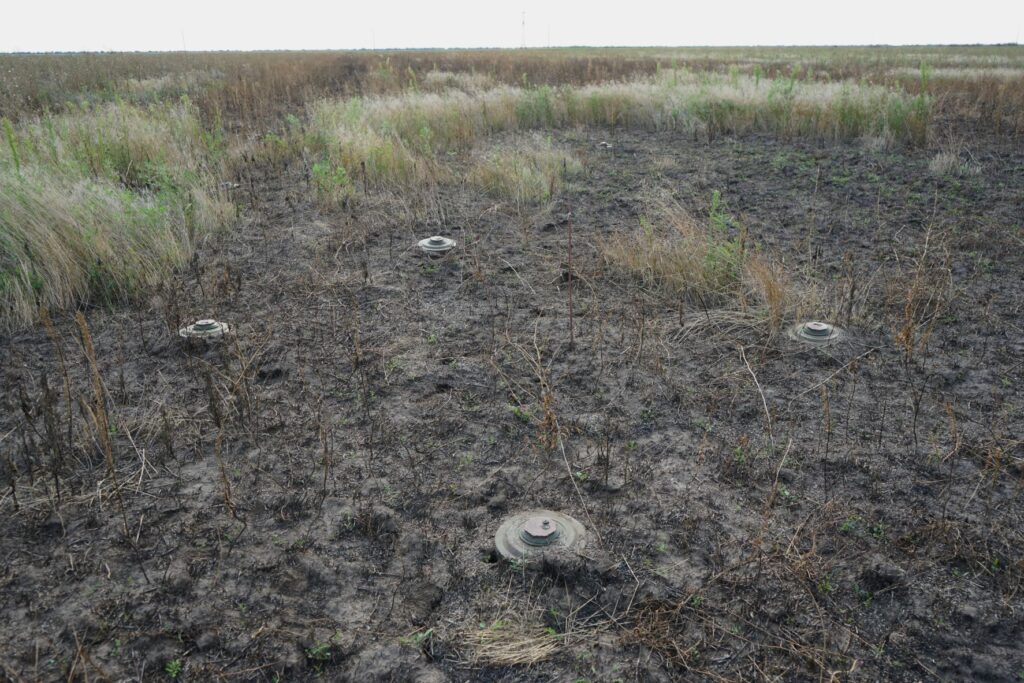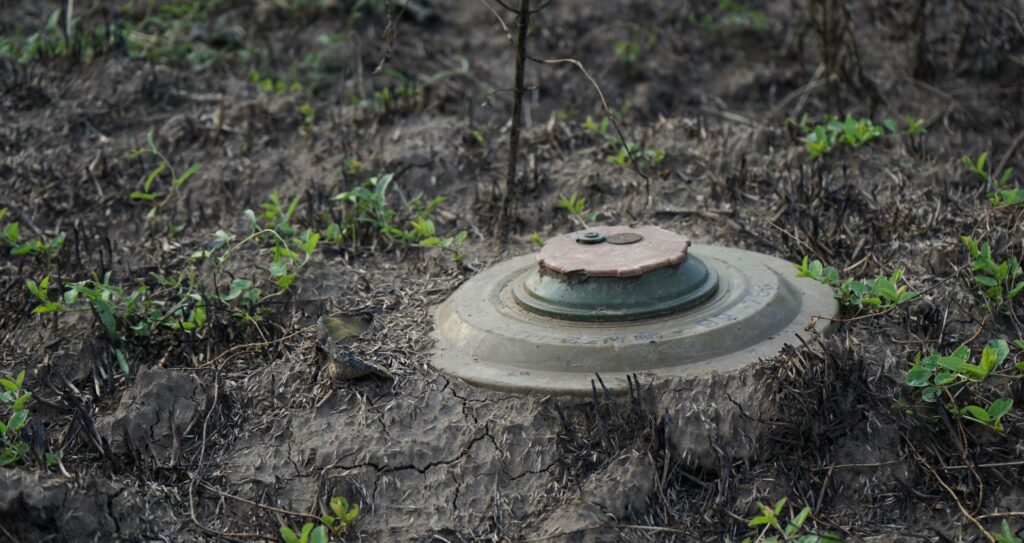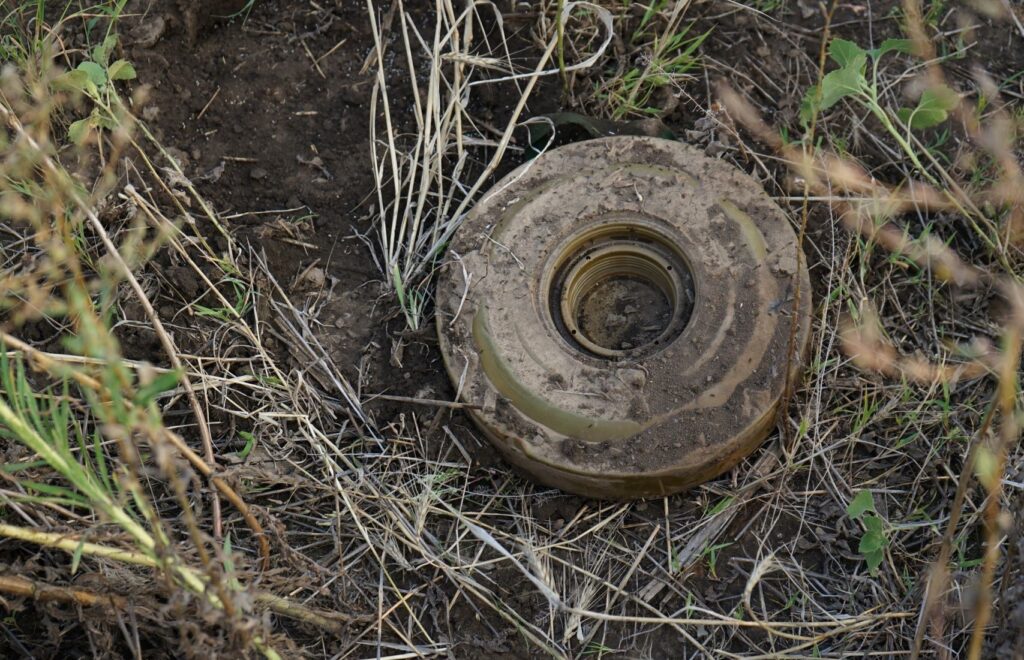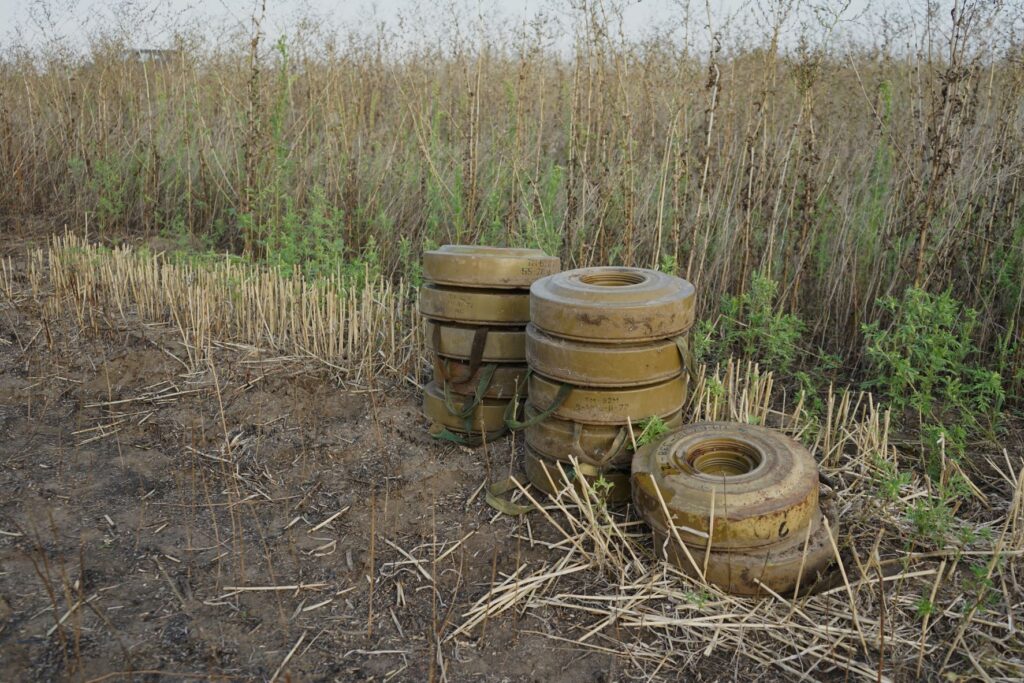Ukraine is now the most mined country on earth

It took about two and half hours of good, bad, and shithouse roads to reach the demining team. When we arrived, they were waiting for us at a crossroads on the edge of their village, sitting in the shade next to their work van. We pulled up, and the team of six heavily-tanned Ukrainians shook our hands with cheerful greetings of ‘dobry den‘ (good day). Their leader, Victor, explained that they were breaking for lunch, and told us to join them for borscht, a traditional Ukrainian soup of meat and vegetables. Hungry after our drive, we readily agreed.
We pulled out behind the team’s white van, and followed it through the quiet village. My colleague mentioned that the back of the vehicle was full of mines, and that as it only had three seats in the front, the rest of the team must be sitting in the back amongst the explosives. I took my foot off the accelerator, allowing a little more distance between us and our guides.
We drove slowly along a road lined with shady trees, then pulled up outside a shed which stood beside a large house. One of the Ukrainian blokes swung a gate open, and the van was backed in. The team then unloaded their haul from the morning’s work: around fifty Russian anti-tank mines. The approximately 30cm diameter mines, their central fuses removed, were carried two at a time into the shed and added to the hundreds already stacked in neat piles. One bloke emptied a fertilizer sack of fuses near the door, alongside rockets, shells, mortar rounds and other battlefield detritus.

With the unloading complete, Victor lead us through a gate to the house. In an open area of the front yard, beneath the dappled shade of a grape vine, the team set up a table and benches for us. A plate loaded with fresh sour dough bread was brought out, along with cut raw onion, capsicum, spicy red pepper and sour cream. One by one we were give a bowl of steaming borscht, and while we ate, Victor told us about his mine clearing operation.
The team were all local townspeople who had volunteered to undertake the dangerous work of demining their district. They supported themselves by doing odd days of paid work, and presumably by growing a lot of their own food. Victor also mentioned that they raised funds by auctioning war souvenirs, like Russian helmets, online. Due to the size of the area, and the scale of the contamination, transport was one of the biggest costs involved in their work. Victor had calculated that it took a litre of diesel for every mine they removed. Despite their scarce resources, they had been able to source a drone, and used it to do an initial scan of an area to be cleared before moving in on foot. Over the previous month, the small, unfunded, volunteer team of five men and one woman had cleared over 2000 mines.
We were keen to see the team in action, so after generous helpings of sweet, locally grown watermelon, we followed their van southwards out of town. After about half an hour’s drive on an heavily potholed road, which included one flat tyre, we pulled over behind Victor’s vehicle. He wanted to show us a Russian anti-tank ditch, which ran perpendicular to the road and out into the paddock. The ditch itself was about two metres deep, and the excavated soil piled on one side created a windrow of similar height. Victor explained that the tank ditch was designed to funnel the Ukrainian armoured vehicles into the nearby minefield that his team were currently clearing.

After moving on a short distance, we watched as the Ukrainians headed into the chest-high grass, without helmets or body armour, and with no equipment other than wide-mouthed wrenches for removing the mine fuses. The Russians had not buried the anti-tank mines, and they sat like little green flying saucers in amongst the grass. One team member went ahead and recorded the location of each mine with a GPS, which would be later added to a mapping database. Coming along behind, a couple of the blokes defused the mines, whilst the others followed them and carried the deactivated mines to a clearing and stacked them up.
Our NGO works closely with an Explosive Ordinance Disposal (EOD) technician, and as we watched the Ukrainians clearing mines, I asked him about the technique they were using. He told me he was concerned for the safety of the team. He explained that removing a fuse by hand and then picking up the mine could be deadly if it had been booby trapped. Another worry was that the Russians may have buried anti-personal mines near the larger anti-tank explosives.
We had travelled to meet the demining team to learn about their work, and see if there was any way we could support them. It was clear to the EOD tech that some basic equipment, which was beyond the financial means of the Ukrainians, would help to reduce the risk they faced every day. He had brought two British Army mine detectors with him, which had been bought with funds he had raised, and presented them to Victor. His face lit up with genuine joy and gratitude, and he watched keenly as the tech unpacked and demonstrated the units.

With the sun low in the sky, the team brought the last of the mines out of the paddock and placed them in the van. We told the Ukrainians that we would return soon, and whilst being careful not to promise what we couldn’t deliver, said we would do our best to support them. After thankyous, hugs and well wishes, we began the slow drive back home.
A Washington Post article published on July 22nd, 2023, states that Ukraine is now the most heavily mined nation on earth, and that:
‘Ukraine’s contaminated territory is so massive that some experts estimate humanitarian clearance would take the approximately 500 demining teams in current operation 757 years to complete.’1
There is a clear need for funding and new technology to deal with the staggering problem of mines in Ukraine, particularly the massive swathes planted in agricultural areas. Until these become available, teams such as Victor’s will continue to remove mines one at a time. A small team of committed volunteers who risk their lives, so their fellow villagers can return to work the land and provide for their families.
I have intentionally excluded the names of locations, towns and people (if I do mention individuals’ names, they have been changed) in my posts about Ukraine, and not included any specific photographs. Although this may seem excessively cautious, this is an appropriate time for excessive caution.
1Sampson, E. and Granados, S., 2023, ‘Ukraine is now the most mined country. It will take decades to make safe’, The Washington Post
If you enjoyed this post, you may also like Deadly Harvest, Mud and Memories
Leave a Reply